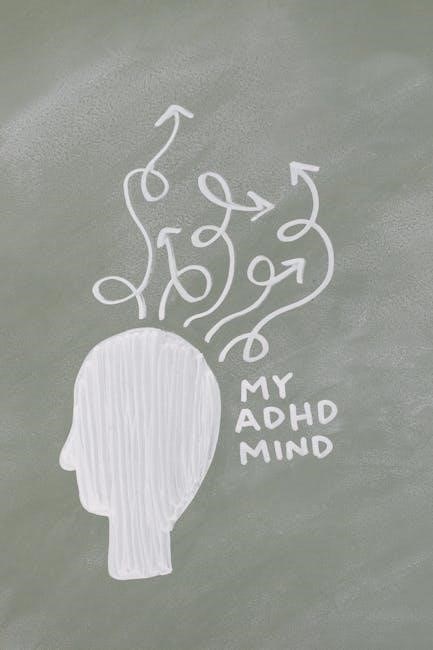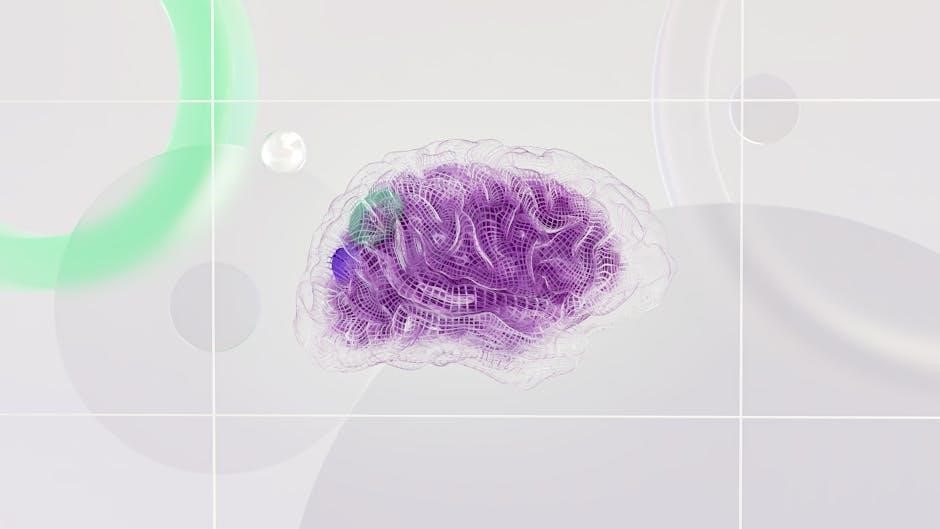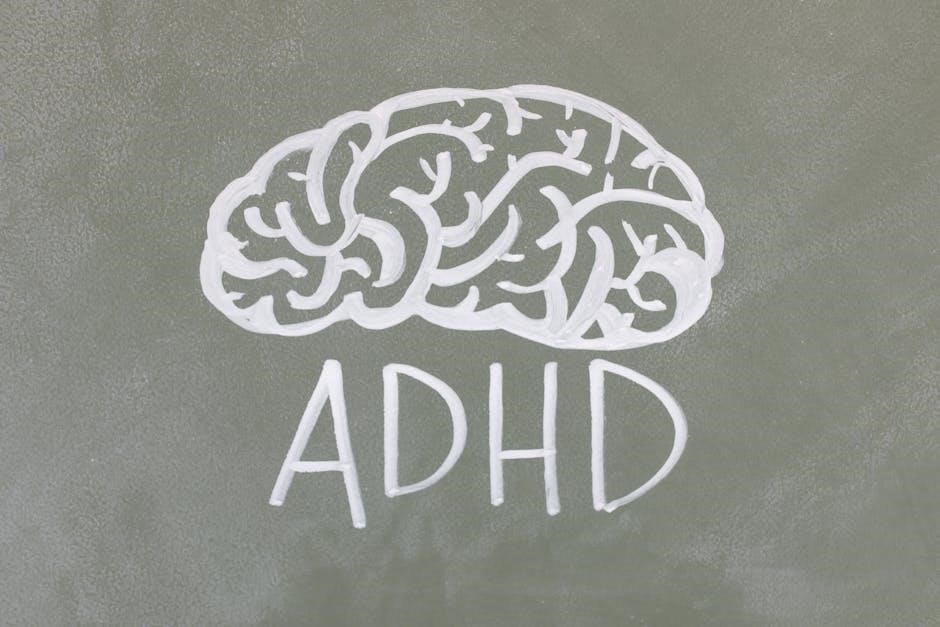The human brain is divided into four lobes: frontal, parietal, temporal, and occipital. Each lobe specializes in distinct functions, enabling cognition, emotion, and sensory processing effectively.
1.1 Overview of Brain Structure
The human brain is primarily composed of the cerebrum, cerebellum, brain stem, and limbic system. The cerebrum, the largest part, is divided into four lobes: frontal, parietal, temporal, and occipital. Each lobe is specialized for unique functions, such as decision-making, sensory processing, and vision. The frontal lobe, located at the front, is responsible for executive functions like planning and problem-solving. The parietal lobe, situated behind it, handles spatial awareness and sensory input. The temporal lobe, on the sides, manages auditory processing and memory, while the occipital lobe at the back focuses on vision. These lobes work together to enable complex cognitive and motor tasks, forming the basis of human thought and behavior.

1.2 Importance of Understanding Brain Lobes
Understanding the brain lobes is crucial for comprehending human cognition, emotion, and behavior. Each lobe’s specialized functions, from the frontal lobe’s role in decision-making to the occipital lobe’s control over vision, highlight their interconnected contributions to overall brain function. This knowledge aids in diagnosing and treating neurological disorders, such as frontal lobe injuries linked to impaired executive functions or temporal lobe damage associated with memory deficits. By studying these lobes, researchers and clinicians can develop targeted therapies, enhancing recovery and improving quality of life for individuals with brain injuries or conditions. This insight also deepens our appreciation of the brain’s complexity and its role in shaping human experiences and interactions with the environment.

Frontal Lobe
The frontal lobe, the largest brain lobe, is located at the anterior part of the cerebrum. It plays a key role in executive functions, decision-making, and motor control.
2.1 Location and Structure
The frontal lobe is the largest of the brain’s lobes, comprising nearly one-third of the cerebrum. It is located in the anterior portion of the brain, resting in the anterior cranial fossa, and extends posteriorly to the central sulcus, which separates it from the parietal lobe. This lobe is divided into subregions, including the prefrontal cortex, premotor cortex, and primary motor cortex. The prefrontal cortex is crucial for higher cognitive functions, while the motor cortex controls voluntary movements. The frontal lobe’s structure is characterized by deep sulci and gyri, which increase its surface area and functional capacity. Its anterior position and extensive neural networks make it central to executive control and behavioral regulation.
2;2 Cognitive Functions
The frontal lobe plays a pivotal role in higher cognitive functions, including reasoning, problem-solving, and decision-making. It is responsible for executive control, enabling tasks like planning, organizing, and flexible thinking. This lobe also manages attention, allowing individuals to focus on specific stimuli while ignoring others. Additionally, it facilitates abstract thought and mental flexibility, which are essential for adapting to new situations. Damage to this area can impair these functions, highlighting its critical role in intellectual and adaptive behaviors. The frontal lobe’s cognitive capabilities are fundamental to complex mental processes, making it indispensable for navigating daily challenges and achieving goals effectively.
2.3 Emotional and Behavioral Roles
The frontal lobe is integral to emotional regulation and behavioral control, influencing personality and social interactions. It manages self-control, enabling individuals to suppress impulsive actions and exhibit appropriate behaviors. This lobe also processes emotions, linking them to decision-making and personal experiences. Damage to this area can lead to impulsivity, emotional instability, or impaired judgment, underscoring its vital role in emotional and social functioning. The frontal lobe ensures that emotional responses align with situational contexts, fostering balanced and adaptive behavior in various settings.

Parietal Lobe
The parietal lobe manages spatial orientation, sensory processing, and environmental interaction. It integrates sensory information, aiding in spatial awareness and navigation, crucial for interpreting the physical world effectively.
3.1 Spatial Awareness and Sensory Processing
The parietal lobe plays a critical role in spatial awareness and sensory processing. It processes sensory information related to touch, temperature, and pain, helping us understand our environment. This lobe integrates sensory data to create a coherent perception of the world, enabling spatial orientation and navigation. Damage to this area can impair the ability to localize sensations or understand spatial relationships. The parietal lobe also contributes to hand-eye coordination and the manipulation of objects, making it essential for tasks like reaching or grasping. Its functions are vital for interpreting sensory input and translating it into meaningful actions, highlighting its importance in daily interactions with the physical world.
3.2 Role in Memory and Learning
The parietal lobe contributes to memory and learning by processing spatial and sensory information, which aids in forming and retrieving memories. It plays a role in episodic memory, particularly those involving spatial contexts. The lobe helps integrate sensory details into coherent experiences, enhancing learning. Damage to this area can impair memory formation and spatial recall. The parietal lobe also supports the consolidation of information, linking sensory input to long-term memory storage. Its ability to process complex sensory data makes it crucial for tasks requiring spatial reasoning and memory, such as navigating familiar environments or recalling object locations. Thus, the parietal lobe is essential for transforming sensory experiences into memorable knowledge, influencing both cognitive and practical aspects of daily life.

Temporal Lobe
The temporal lobe plays a key role in auditory processing, memory, and language. It integrates sensory input and emotional experiences, crucial for hearing, speech, and memory formation.
4.1 Auditory and Speech Functions
The temporal lobe is crucial for processing auditory information and speech. It houses the primary auditory cortex, which interprets sound patterns, enabling us to recognize and understand speech. This lobe also contains Wernicke’s area, essential for comprehension of written and spoken language. Damage to these regions can lead to speech disorders like aphasia. The temporal lobe’s role in memory further supports language processing, linking sounds to meanings and contexts. It facilitates the integration of auditory inputs with emotional and cognitive experiences, making it vital for communication and learning. Overall, the temporal lobe’s auditory and speech functions are fundamental to how we interact with and interpret the world around us.
4.2 Memory and Emotional Processing
The temporal lobe plays a pivotal role in memory and emotional processing. It houses the hippocampus, a structure critical for forming and consolidating new memories, particularly those tied to emotions. The amygdala, also located here, processes emotional reactions, associating experiences with fear or pleasure. Damage to these areas can impair memory recall and emotional regulation. The temporal lobe’s ability to link emotions with memories enhances learning and personal identity. Its dysfunction is linked to conditions like Alzheimer’s disease and emotional disorders, highlighting its significance in cognitive and emotional well-being. This lobe’s functions underscore the deep interplay between memory and emotion, shaping our responses and experiences.

Occipital Lobe
The occipital lobe, located at the brain’s posterior, specializes in processing visual information, interpreting colors, shapes, and movements, enabling recognition of patterns and objects.
5.1 Vision and Visual Processing
The occipital lobe, located at the posterior of the brain, is specialized for processing visual information. It interprets signals from the eyes, enabling recognition of colors, shapes, and movements. Damage to this lobe can impair vision or cause blindness. The occipital lobe works with other brain regions to enhance visual perception, ensuring seamless integration of sensory data. Its complex neural networks are essential for detecting patterns and understanding visual stimuli, making it a critical component of how we interact with the world. Without the occipital lobe, visual processing would be severely limited, highlighting its vital role in perception and cognition.

Interconnectedness of Brain Lobes
The brain lobes seamlessly collaborate, ensuring integrated brain function. This interconnectedness allows for efficient communication and coordination, enabling complex cognitive, emotional, and sensory processes to function harmoniously together.
6.1 Communication Between Lobes
The brain lobes communicate through intricate neural pathways, ensuring seamless information exchange. These connections enable the integration of sensory, cognitive, and emotional data. For instance, the frontal lobe collaborates with the parietal lobe to process sensory inputs, while the temporal lobe works alongside the occipital lobe to interpret auditory and visual information; This interplay allows for complex functions like decision-making, memory formation, and sensory perception. Damage to these pathways can disrupt coordination, leading to cognitive or motor impairments. The brain’s interconnectedness highlights its remarkable ability to function as a unified system, despite its specialized lobes. This communication is essential for maintaining overall brain efficiency and enabling adaptive responses to environmental demands.
6.2 Integrated Brain Function
The brain’s lobes work harmoniously to ensure cohesive mental and physical processes. Integrated brain function allows for the synchronization of sensory, cognitive, and emotional information. For example, the frontal lobe’s executive functions align with the parietal lobe’s sensory processing to enable problem-solving and spatial awareness. Similarly, the temporal lobe’s role in auditory processing complements the occipital lobe’s visual processing, facilitating comprehensive understanding. This integration is vital for tasks like language comprehension, memory retrieval, and motor coordination. When these connections are disrupted, such as in neurological disorders, it can lead to impairments in perception, cognition, or behavior. The brain’s ability to integrate lobe functions underscores its complexity and adaptability in managing diverse physiological and psychological processes efficiently. This interconnectedness is fundamental to overall brain health and functionality.

Clinical Significance of Brain Lobes
Damage to specific brain lobes can lead to impairments in motor skills, speech, memory, or vision, highlighting their vital roles in brain function.

7.1 Disorders Associated with Lobe Damage
Different brain lobes are associated with specific disorders when damaged. Frontal lobe damage can lead to impaired decision-making, reduced impulse control, and personality changes. Parietal lobe damage often results in spatial awareness deficits and sensory processing issues. Temporal lobe damage can affect memory, speech, and auditory processing, potentially causing conditions like aphasia or epilepsy. Occipital lobe damage primarily impacts vision, leading to blindness or visual field deficits. Understanding these lobe-specific disorders is crucial for accurate diagnosis and effective treatment of neurological conditions. Each lobe’s unique functions highlight the brain’s intricate organization and the consequences of localized damage.
